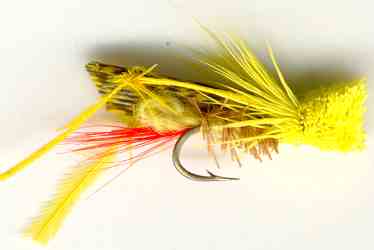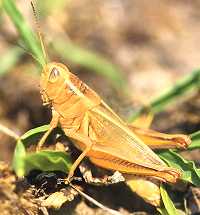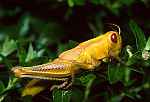Yellow Hopper Dry Fly
To catch trout use a Yellow Hopper Dry Fly pattern. Trout do not care if their food rises up from the stream bottom to hatch, or if it falls in from above. Trout pay close attention to the surface and this makes terrestrials an important food source.

GRASS HOPPER AND CRICKET FLY PATTERNS. Hook size 12 - $US each
Anglers should not neglect flies that imitate terrestrial insects. Terrestrials can make up more than 80% of a fish's diet at certain times of the year--especially in late summer and early fall. Grasshoppers survive well after the first frosts, although they are less vigorous, and hence more vulnerable. The will continue to catch fish in most places well into October. ( Terrestrial insects are any fish food that has no aquatic stage like grasshoppers, ants, crickets, beetles, leafhoppers, caterpillars, inch worms, spiders, snails) At certain time of year grasshoppers become abundant. If you are in luck, a wind will blow these wonderful fish snacks into your favorite waters. It is then a great time to be a fly fisherman. A delicate presentation is not critical then because even big selective trout (largemouth or smallmouth bass, bluegill, etc.) are looking for the tell-tale splat of this helpless terrestrial as it flops into their eating zone. Second, these are big flies and you can use short leaders that are easy to cast. Moreover, even if a hopper has been chewed on a few times, the fish don't seem to mind.
Grasshoppers can swim by kicking their hind legs in unison, using the same method as they employ when jumping. This is simply mimicked by fishing the fly on the surface and retrieving it with short sharp pulls. Continue for about three feet and then let your fly drift for 20 seconds before recommencing the retrieve. This imitates the grasshopper having a rest. Hoppers generally hatch from eggs in June and July and are full grown by mid-August. The adults continue to feed until the first frost. The eggs are laid under ground in late September and October. The best hopper fishing occurs in August and early September. They like hot weather, and you will find your best hopper fishing on hot windy afternoons. The only downside with hopper patterns is that they don't work all year round but keep some in your fly box just in case. Trout move into shallower riffles downwind from riverbanks near hayfields as the day warms up, on the lookout for helpless struggling grasshoppers locust and crickets. Earlier in the day these fish will be hold up in deeper water, along seams. banks and drop offs. Once it gets warmer they return to the areas where they have feasted on these unlucky insects in the past.

Banks are the key to successfully fishing Hoppers. Most grasshoppers that find their way into the water's surface are concentrated in the foliage along the banks. Banks also provide cover and shade for fish during hot summer afternoons. Thus fish, which move to the banks for cover and shade, are putting themselves in the exact place where grasshoppers are most available. On large rivers, grasshoppers should be cast as close to the banks as possible. This is more important in streams where banks are slightly undercut and where vegetation hangs out over the water. On small streams, trout often see grasshoppers all across the water and will be willing to take an imitation in the middle of the stream.
I was fishing on a small river in the French Alps last summer. There were fields either side of the river but the banks were wooded. I was surrounded by breath taking views of snow covered mountains. The sun was out and it was a perfect day. The early morning hatch had finished and takes were getting harder and harder as the fish started to hide from the midday sun. I noticed some light green grass hoppers jumping from rock to rock. Some missed and floated in the water, struggling against the current. Then there was a sudden splash. A trout had struck and successfully gained a large nourishing meal. One of these struggling creatures passed near my boot. I scooped it up from the water and put him on the bank where he could dry. This idiotic insect, with a death wish, jumped straight back into the river instead of the relative safety of the woods and fields. I observed that trout would move from their midday resting place to attack a grass hopper floating in the surface film where as they would not move for a standard mayfly pattern. Trout know that grass hoppers are a very substantial meal compared with a mayfly and therefore consider them worth the effort and energy of an attack



Fly Fishing books

